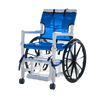Important Considerations for First-Time Wheelchair Users: A Comprehensive Guide

Using a wheelchair for the first time can feel overwhelming, but with the right information and preparation, it can be a positive transition toward enhanced mobility and independence. Whether you need a wheelchair for temporary recovery or as a long-term solution, understanding the basics of choosing the right wheelchair, ensuring proper posture, and modifying your environment are key to making the experience as smooth as possible. In this guide, we’ll delve into important tips and practical considerations to help you confidently navigate this new chapter in mobility.
1. Choosing the Right Wheelchair
The first and perhaps most crucial step is selecting a wheelchair that fits your specific needs and lifestyle. There are two primary types: manual wheelchairs and electric (power) wheelchairs.
Key Factors to Consider:
- Duration of Use: If your wheelchair use is short-term, such as post-surgery recovery, a manual wheelchair may suffice. However, for those who require long-term use or greater autonomy, an electric wheelchair offers enhanced mobility and ease.
- Weight and Portability: If you frequently travel or need to store your wheelchair in tight spaces, a lightweight, foldable manual chair or a compact electric chair is a practical choice.
- Environment: Consider where you’ll be using your wheelchair the most. If you are navigating indoor spaces or smooth surfaces, a more compact design may work. For outdoor use, larger wheels and a sturdier frame are preferable to handle uneven terrain.
Consult with a healthcare professional or mobility specialist to assess your individual requirements and choose a chair that best suits your lifestyle.
2. Ensuring Proper Posture and Positioning
Proper posture is essential for avoiding discomfort and preventing long-term health issues such as pressure sores, back pain, and joint strain. Here are a few important guidelines:
Posture Tips:
- Seat Height and Cushioning: Your seat height should allow your feet to rest comfortably on the footrests, with knees at a 90-degree angle. A wheelchair that is too high or low can cause discomfort and strain.
- Use Supportive Cushions: Consider pressure-relief cushions to maintain proper posture and reduce the risk of pressure sores, particularly if you’ll be sitting for long periods.
- Back and Arm Support: Ensure your back remains aligned with the backrest to maintain a healthy posture, and adjust the armrests to allow your arms to rest comfortably without straining your shoulders.
Regularly repositioning yourself can also help prevent pressure sores, so if possible, shift your weight periodically throughout the day.
3. Mastering Maneuverability and Safe Navigation
Learning how to maneuver your wheelchair efficiently and safely is critical, especially when you are in unfamiliar environments. Whether you're using a manual or electric wheelchair, mastering control is key to maintaining independence.
Key Maneuvering and Safety Tips:
- Manual Wheelchairs: For those using manual chairs, building upper body strength is crucial. Practice using your arms to propel yourself forward, backward, and turn efficiently. Practice on both smooth surfaces and more challenging terrains to become comfortable with a range of environments.
- Electric Wheelchairs: For powered wheelchairs, familiarize yourself with the joystick or controls and practice maneuvering in different settings. Pay attention to the battery life and ensure you have a charger with you when traveling longer distances.
- Braking and Stability: Always engage your brakes when stationary to prevent rolling, especially on inclines or uneven surfaces. Many wheelchairs come with seat belts, which provide extra security when going downhill or over bumps.
- Be Mindful of Hazards: Whether navigating indoors or outdoors, always be aware of potential hazards such as stairs, curbs, or uneven surfaces. Consider practicing on various terrains to build confidence and preparedness.
4. Modifying Your Home for Accessibility
Making your home or living space wheelchair accessible is essential for ease of mobility. Small adjustments can make a significant difference in your comfort and ability to move around freely.
Accessibility Tips:
- Install Ramps: If your home has stairs at the entrance, installing ramps is crucial for easy access. Ensure the ramp has a gentle slope and sturdy handrails for additional safety.
- Widen Doorways: Narrow doorways can make wheelchair navigation difficult. Consider widening doorways or using offset hinges to allow more space.
- Clear Clutter: Keep hallways and rooms free from clutter to make wheelchair maneuvering easier. Rugs should be removed or secured to avoid tripping or getting stuck.
- Lower Countertops and Switches: For ease of access, lowering countertops, light switches, and cupboards can significantly improve your ability to complete daily tasks independently.
5. Building Upper Body Strength for Manual Wheelchair Users
For manual wheelchair users, having strong upper body muscles is crucial for mobility. Building strength in your arms, shoulders, and back will improve your ability to propel yourself, reduce fatigue, and maintain your independence.
Exercises to Improve Strength:
- Arm Resistance Training: Use resistance bands or light weights to build arm and shoulder strength. Focus on exercises like bicep curls, shoulder presses, and tricep extensions.
- Core Strengthening: A strong core provides stability when pushing yourself in a manual wheelchair. Incorporate exercises like seated leg lifts, twists, and other core-strengthening movements.
- Hand and Grip Strength: Work on improving hand strength with grip trainers or squeezing a stress ball, which will enhance your ability to handle the wheelchair’s rims effectively.
Consult with a physical therapist who can recommend exercises tailored to your strength level and mobility needs.
Conclusion
Using a wheelchair for the first time can present challenges, but with the right knowledge and preparation, you can turn this experience into an opportunity to enhance your independence and quality of life. By choosing the right wheelchair, focusing on proper posture, mastering safe maneuvering, and making necessary home adjustments, you can confidently navigate your new mobility experience. Don’t hesitate to seek professional advice from healthcare providers to tailor these tips to your specific needs and ensure long-term comfort and safety.
Visit Dansons Medical today to explore our wide range of affordable, high-quality wheelchairs and other medical equipment that can help improve your mobility and comfort. Let us support you in achieving a more independent, fulfilling lifestyle.- Dansons Medical Support


 Lifts
Lifts
 Patient Lifts
Patient Lifts
 Stand Assists
Stand Assists
 Standing Aids
Standing Aids
 Slings
Slings
 Parts & Accessories
Parts & Accessories
 Wheelchairs
Wheelchairs
 Ergonomic
Ergonomic
 Portable
Portable
 Reclining
Reclining
 Standing
Standing
 Sporting
Sporting
 Bariatric
Bariatric
 Ramps
Ramps
 Modular
Modular
 Portable
Portable
 Parts & Accessories
Parts & Accessories
 Walking Aids
Walking Aids
 Rollator Walkers
Rollator Walkers
 Canes
Canes
 Crutches
Crutches
 Parts & Accessories
Parts & Accessories
 Scooters
Scooters
 4-Wheel
4-Wheel
 Folding
Folding
 Parts & Accessories
Parts & Accessories
 Nursing
Nursing
 Pregnancy Comfort
Pregnancy Comfort
 Self-Care
Self-Care
 Pump Parts
Pump Parts
 Exercise Equipment
Exercise Equipment
 Treadmills
Treadmills
 Walking Pads
Walking Pads
 Rowing Machines
Rowing Machines
 Strength & Conditioning
Strength & Conditioning
 Massage Chairs
Massage Chairs
 Saunas
Saunas
 Hot & Cold Tubs
Hot & Cold Tubs
 Stethoscopes
Stethoscopes
 Surgical Instruments
Surgical Instruments
 Forceps
Forceps
 Scalpels
Scalpels
 IV Poles
IV Poles
 Oxygen
Oxygen
 Beds
Beds
 Electric Beds
Electric Beds
 Standing Beds
Standing Beds
 Mattresses
Mattresses
 Bed Accessories
Bed Accessories
 Bed Parts
Bed Parts
 Chairs
Chairs
 Medical Recliners
Medical Recliners
 Phlebotomy Chairs
Phlebotomy Chairs
 Stools & Task Chairs
Stools & Task Chairs
 Parts & Accessories
Parts & Accessories
 Tables
Tables
 Overbed Tables
Overbed Tables
 Medical Tables
Medical Tables
 Recovery Couches
Recovery Couches
 Cabinets
Cabinets
 Pool
Pool
 Pool Lifts
Pool Lifts
 Pool Fitness & Therapy
Pool Fitness & Therapy
 Pool Access Chairs
Pool Access Chairs
 Slings
Slings
 Parts & Accessories
Parts & Accessories
 Bath
Bath
 Toileting Aids
Toileting Aids
 Bath Lifts
Bath Lifts
 Shower Seats
Shower Seats
 Parts & Accessories
Parts & Accessories
 Portable Shower
Portable Shower
 Dansons Products
Dansons Products
 Transfer Aids
Transfer Aids
 Cushions
Cushions
 eBooks
eBooks
 Helpful Articles
Helpful Articles
 Reviews
Reviews
 Contact Us
Contact Us
 Create Account
Create Account
 Request a Quote
Request a Quote

Comments 0